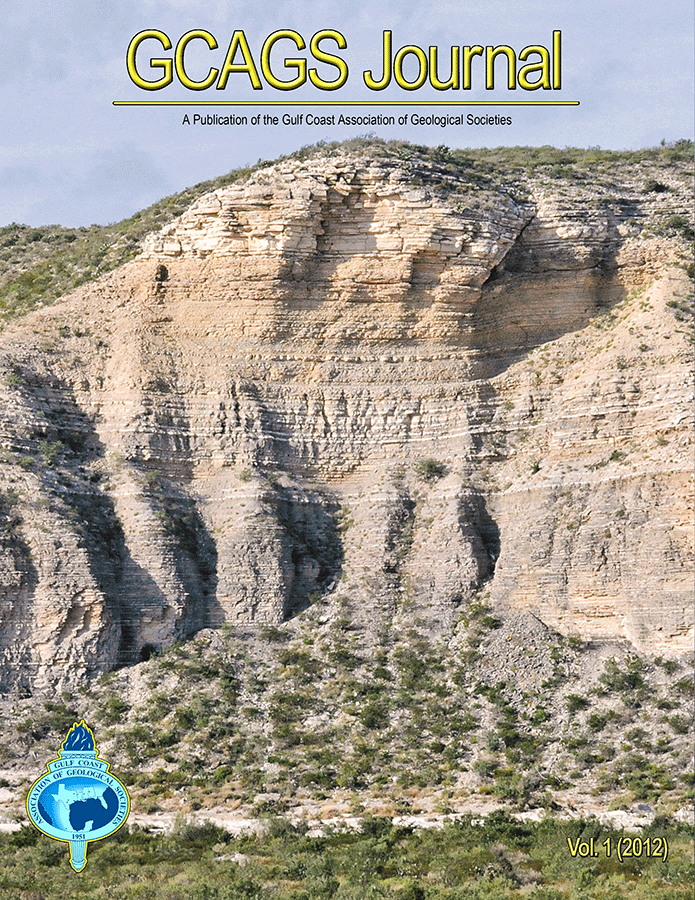
The online availability of the 2012 GCAGS Journal articles is made possible solely by contributions and support of Shell.
Contents
Preface
Correlation of Resource Plays and Biodiversity Patterns:
Accumulation of Organic-Rich Shale Tracks Taxonomic
Turnover
Jennifer D. Eoff
Historical Shoreline Change through 2007, Texas Gulf
Coast: Rates, Contributing Causes, and Holocene
Context
Jeffrey G. Paine, Sojan Mathew, and Tiffany Caudle
Salt Tectonics and its Effect on Sediment Structure
and Gas Hydrate Occurrence in the Northwestern Gulf
of Mexico from 2D Multichannel Seismic Data
Dan’l Lewis and William Sager
Structure of the Alleghanian Thrust Belt under the
Gulf Coastal Plain of Alabama
Delores M. Robinson, Ryan M. Bailey, and Andrew M. Goodliffe
Revisiting the Hydrologic Divide between the San
Antonio and Barton Springs Segments of the Edwards
Aquifer: Insights from Recent Studies
Brian A. Smith, Brian B. Hunt, and Steve B. Johnson
The Cretaceous-Paleogene Boundary on the Brazos River,
Texas: New Stratigraphic Sections and Revised
Interpretations
Malcolm B. Hart, Thomas E. Yancey, Andrew D. Leighton,
Brent Miller, Chengjie Liu, Christopher W. Smart, and Richard J. Twitchett
Burial and Thermal History of the Haynesville Shale:
Implications for Overpressure, Gas Generation, and
Natural Hydrofracture
Jeffrey A. Nunn
Regional Map of the 0.70 psi/ft Pressure Gradient
and Development of the Regional Geopressure-Gradient
Model for the Onshore and Offshore Gulf of Mexico
Basin, USA
Lauri A. Burke, Scott A. Kinney, Russell F. Dubiel, and
Janet K. Pitman
Stratigraphic and Structural Framework of the
Clemente-Tomas and Corsair Growth Fault Systems
in the Texas Continental Shelf
Olabisi Ajiboye and Seiichi Nagihara |
|
2012 (Vol. 1)

Cover: Outcrop exposure of the Eagle Ford Group in Lozier Canyon, Terrell County, Texas. The underlying Buda Limestone forms the resistant light-colored outcrops near the valley floor, and the overlying Austin Chalk forms the resistant cap. The Lozier Canyon locality provides a remarkable exposure of the entire Eagle Ford section, providing key insight into the South Texas Eagle Ford oil and gas play. See Donovan et al. herein for additional details. Photo courtesy of A. D. Donovan.
Modeling the Mesozoic-Cenozoic Structural Evolution
of East Texas
Ofori N. Pearson, Elisabeth L. Rowan, and John J. Miller
Eastward Shift of Deepwater Fan Axes during the
Miocene in the Gulf of Mexico: Possible Causes and
Models
John W. Snedden, William E. Galloway, Timothy L. Whiteaker,
and Patricia E. Ganey-Curry
Current and Future Water Demand of the Texas Oil
and Gas and Mining Sectors and Potential Impact on
Aquifers
Jean-Philippe Nicot
The Eagle Ford Outcrops of West Texas: A Laboratory
for Understanding Heterogeneities within
Unconventional Mudstone Reservoirs
Arthur D. Donovan, T. Scott Staerker, Aris Pramudito,
Weiguo Li, Matthew J. Corbett, Christopher M. Lowery,
Andrea Miceli Romero, and Rand D. Gardner |
